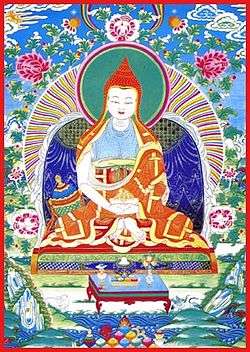Vimalamitra

| Part of a series on |
| Tibetan Buddhism |
|---|
 |
|
|
Practices and attainment |
|
Institutional roles |
|
History and overview |
|
|
Vimalamitra (Chinese: 無垢友, Wylie: དྲི་མེད་བཤེས་གཉེན་ ) was an 8th-century Indian monk. His teachers were Buddhaguhya, Jñānasūtra and Śrī Siṃha.[1] He was supposed to have vowed to take rebirth every hundred years,[2] with the most notable figures being Rigzin Jigme Lingpa, Khenchen Ngagchung, Kyabje Drubwang Penjor Rinpoche and Kyabje Yangthang Rinpoche. ' Vimalamitra' was more known to the Bhutanese and Tibetans as 'Penchen Vimalamitra' meaning 'the Great Pandita'. He was one of the eight teachers of the great Indian adept Guru Padmasambhava. Centuries later he was adopted as a literary character of terma and was attributed various works. Chatral Sangye Dorji (1913-2016) was said to have received a mala rosary from a man who was at the time dressed as an Indian Sadhu. It was only later that Rinpoche told his attendants that he received a mala on that day from Vimalamitra in real. The attendants were curious and went back to the place where they met a sadhu only to be left lost and I found. The sadhu was not to be found anywhere. One scholar remarked that the historical Vimalamitra "would have been astonished to find himself the focus of such a tradition."[3]
Attributed works
Among the works which have been attributed to Vimalmitra is the Vima Nyingthig. However, scholars are not in agreement as to which works he actually authored.[2]
References
- ↑ Gruber, Joel Stephen (2016). "Vimalamitra : The Legend of an Indian Saint and His Tibetan Emanations - Alexandria Digital Research Library". Alexandria Digital Research Library. Retrieved 2017-08-03.
- 1 2 Gruber, Joel (2012). "Vimalamitra". The Treasury of Lives. Retrieved 2017-08-03.
- ↑ Davidson, Ronald M. Tibetan Renaissance, p. 229. Columbia University Press, 2005.